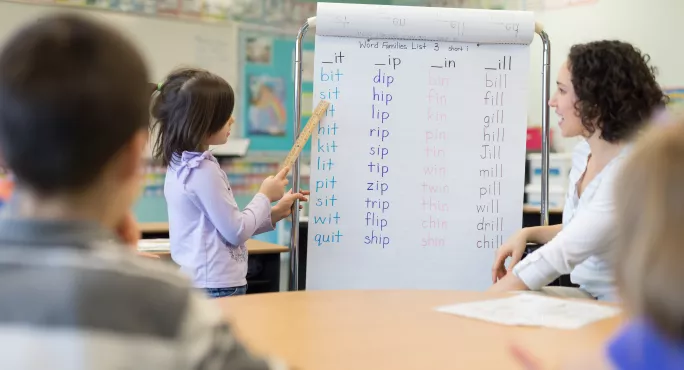Covid: Year 2 literacy worst hit by pandemic

The disruption caused by the Covid-19 pandemic has held back Year 2 pupils’ progress in grammar, punctuation and spelling by three months, compared with 2019 levels, new research published today has revealed.
The research, which analyses data taken from progress in the Grammar, Punctuation and Spelling Assessment tests (GPS) in spring 2020, 2021 and 2022, shows that Year 2 pupils’ progress has been worst hit by the crisis.
All primary year groups are on average two months behind pre-pandemic levels for all, despite some recovery, compared with three months for Year 2 pupils, according to the Nuffield Foundation-funded study published by Hodder Education and School Dash this morning.
- Year 1: ‘Real concern’ over Covid impact on Year 1 reading
- Covid catch-up: More catch-up cash ‘needed for 3-month reading gap’
- Catch-up: Primary schools ‘should focus on Year 3’
It shows the disadvantage gap in GPS remains above pre-pandemic levels (autumn 2019) in all year groups except Year 3 and has increased in Years 2, 5 and 6 since autumn 2020.
Over all year groups, the attainment gap is now largest across the North East and East.
The negative difference in mean standardised scores was just over seven in each of those year groups.
The research used aggregate results from more than 700,000 primary school tests taken at more than 1,500 schools during spring 2022 and compares these to the results of previous school years.
Regional variation in pupil attainment
The report shows that there is also regional variation in GPS pupil attainment from spring 2020 to 2022.
It studied data from three regional groups: North (North East, North West and Yorkshire and The Humber), Midlands (East Midlands and West Midlands) and South (East of England, London, South East and South West).
The analysis used “effect sizes” to compare attainment levels between different groups and across time periods.
The larger the negative change in effect size, the larger the attainment gap and effect on learning was likely to be.
The negative effect size was largest in the North in Years 2, 3 and 4, indicating that “on average, children in schools in the North remain further behind their peers”.
Year 5s in the South were the only group estimated to be at the pre-pandemic attainment level (where the effect size is 0).
Reading attainment gap
Analysis also found that Years 1 and 2 are still two months behind pre-pandemic levels in reading when comparing PIRA reading test data between spring 2020 and spring 2022.
All other year groups appear to be “back on track”, according to the report.
While the gap still remains above pre-pandemic levels, the research showed the difference in mean standardised schools for pupil premium and their non-pupil premium peers has reduced in all primary year groups except Year 6.
Overall, the North West and the East had the largest attainment gap across all year groups when comparing spring 2021 and 2022.
Maths attainment gap
Similarly, the report showed the disadvantage gap for maths attainment had reduced compared with spring 2021 (but remained above pre-pandemic levels) in all years apart from Year 6, where it had widened since last year.
Overall, analysis showed that on average, all year groups improved in maths in spring 2022, compared with spring 2021.
And pupils in the Midlands showed the smallest attainment gains compared with other regions.
The report said that ”given these results, it will be especially important to provide support for disadvantaged Year 6 children transitioning to secondary schools”.
There are ‘still challenges ahead’
Katie Blainey, director of assessment product at RS Assessment, said it was “fantastic” that the “hard work undertaken by teachers and staff across the country” had made a difference.
But she warned that there were “still challenges ahead”.
Ms Blainey said it was important to note that key stage 1 had been “particularly negatively impacted by school closures” and “pupils in those years are still behind pre-pandemic attainment levels in reading”.
“In reading and GPS, the attainment gap between disadvantaged pupils and their peers is still larger than it was before the pandemic.”
She also said that pupils in the North did not see as much progress, “indicating additional support may be required in these areas in order to return to pre-pandemic levels”.
A Department for Education spokesperson said that “raising standards of literacy” across England was “fundamental to our work to make sure that every child has the same opportunities to succeed, wherever they live”.
The spokesperson said that this was why the DfE had set the “ambitious target” for 90 per cent of children to leave primary school at the expected standard in reading, writing and maths by 2030.
“Our ambitious education recovery programme is already getting children back on track following the pandemic, with the revolutionary National Tutoring Programme providing nearly two million courses of high-quality tuition for the children and young people who need it most, together with additional funding for schools to use to provide further tailored support for pupils.”
You need a Tes subscription to read this article
Subscribe now to read this article and get other subscriber-only content:
- Unlimited access to all Tes magazine content
- Exclusive subscriber-only stories
- Award-winning email newsletters
Already a subscriber? Log in
You need a subscription to read this article
Subscribe now to read this article and get other subscriber-only content, including:
- Unlimited access to all Tes magazine content
- Exclusive subscriber-only stories
- Award-winning email newsletters
topics in this article



